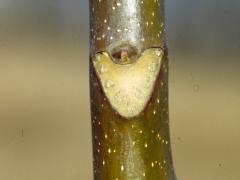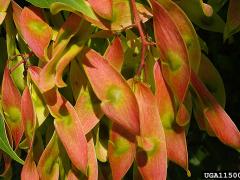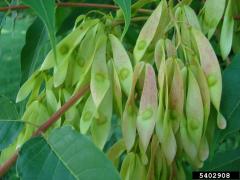Invasive Species: Ailanthus altissima, Tree of Heaven
Tree of heaven forms dense, clonal thickets that displace native species and can rapidly invade fields, meadows, and harvested forests. This invasive tree species is extremely tolerant of poor soil conditions and can even grow in cement cracks. Tree of heaven is not shade tolerant, but it easily invades disturbed forests or forest edges, causing habitat damage. Tree of heaven, native to Asia, was introduced in North America in 1748 by a Pennsylvania gardener. It was widely planted in cities because of its ability to grow in poor conditions. Management and control efforts for tree-of-heaven continue across the United States at great economic cost.
What are invasive species, and why should we be concerned about them?
Taxonomy: Scientific and Common Names for This Species
Sapindales > Simaroubaceae > Ailanthus altissima (P. Mill.) Swingle
Synonym(s): ailanthus, copal tree, tree of heaven
Ailanthus altissima – USDA PLANTS Profile
Distribution Maps
tree of heaven – The reported distribution of this invasive species across the United States (Source: Invasive Plant Atlas of the United States)
Up-to-the-minute distribution maps and why they are important
Reporting This Invasive Species
What is the best way to report the occurrence of an invasive species?
How to report an invasive species sighting to EDDMapS – Early Detection & Distribution Mapping System
EDDMapS – Report an invasive species to EDDMapS.
County Extension Offices – Find your county Extension office on this map provided by USDA.
How to Identify Tree of Heaven
This invasive species can be identified by looking for the characteristics described in the paragraphs that follow.
Tree
Tree of heaven is a rapidly growing, typically small tree that reaches up to 80 ft (24.4 m) in height and 6 ft (1.8 m) in diameter. The image on the left shows this tree growing out of a sidewalk. It has large leaf scars on the twigs.
 |
 |
| Annemarie Smith, ODNR Division of Forestry, bugwood.org | Daniel Herms, Ohio State University, bugwood.org |
Foliage
Foliage is one of the best identifying characteristics for this species. The leaves are pinnately compound and from 1 to 4 ft (0.3 to 1.2 m) in length, with 10 to 41 leaflets. Tree of heaven resembles native sumac and hickory species, but it is easily distinguished by the glandular, notched base on each leaflet.
 |
 |
| Karan A. Rawlins, University of Georgia, bugwood.org | James H. Miller, USDA Forest Service, bugwood.org |
Flower
Flowering occurs in early summer, when large clusters of yellow flowers develop above the leaves.
 |
 |
| Leslie J. Mehrhoff, University of Connecticut, bugwood.org | Leslie J. Mehrhoff, University of Connecticut, bugwood.org |
Fruit
Fruit produced on female plants are tan to reddish, single-winged, and wind- and water-dispersed.
 |
 |
| Chuck Bargeron, University of Georgia, bugwood.org | Annemarie Smith, ODNR Division of Forestry, bugwood.org |
Native Species That Resemble Tree of Heaven
Rhus spp.,sumac species – Images at Forestryimages.org
 |
 |
| Dave Powell, USDA Forest Service, bugwood.org | Ted Bodner, Southern Weed Science Society, bugwood.org |
walnut
Juglans spp., walnut species – Images at Forestryimages.org
 |
 |
| Paul Wray, Iowa State University, bugwood.org | Paul Wray, Iowa State University, bugwood.org |
Additional Images for Tree of Heaven
tree of heaven – Images at invasive.org
Learning Resources for Tree of Heaven
Ailanthus altissima Identification Card – U.S. Fish and Wildlife Service
Ailanthus altissima Fact Sheet – U.S. Fish and Wildlife Service
Ailanthus altissima Fact Sheet – UW-Extension Weed Science
Additional Information, Biology, Control and Management Resources
Control and management recommendations vary according to individual circumstances. Location, habitat, weather, and a variety of other conditions are factors that help determine the best treatment choice. To find the safest and most effective treatment for your situation, consult your state’s land-grant institution. If you will use chemicals as part of the control process, always refer to the product label.
United States Land-Grant University System – Find your Land-Grant University’s College of Agriculture, University Cooperative Extension Service, or other related partner on this map provided by USDA.
Fact Sheet – Pennsylvania Department of Conservation and Natural Resources
Nonnative Invasive Plants of Southern Forests – USDA Forest Service
Plant Invaders of Mid-Atlantic Natural Areas – National Park Service and U.S. Fish and Wildlife Service
Southeast Exotic Pest Plant Council Invasive Plant Manual – Southeast Exotic Pest Plant Council (SE-EPPC)
Weeds Gone Wild: Alien Plant Invaders of Natural Areas – Plant Conservation Alliance
Element Stewardship Abstract – The Nature Conservancy
Invasive Plant Atlas of New England – University of Connecticut
Weed of the Week – USDA Forest Service
